#green software development
Explore tagged Tumblr posts
Text
Sustainability and technology are converging to create powerful solutions for a greener future. In 2025, Green Tech software companies are building innovative platforms that help businesses reduce carbon footprints, optimize energy use, and promote environmental responsibility. This blog features the Top 10 Green Tech Software Development Companies — June 2025 Rankings, recognized for their commitment to eco-friendly innovation, smart energy solutions, and climate-focused technology. Discover the leading firms driving digital transformation while supporting global sustainability goals.
0 notes
Text

Sustainable Software Development
By optimizing code and using efficient practices, sustainable software development can lead to a smoother user experience and reduced maintenance costs. This leads to a competitive edge and a more sustainable future. Feather Softwares provides real-world experience through internship programs in areas like Front-End Development, SEO, and Full-Stack Programming. Are you frustrated by low website traffic and lack of online sales? Feather Softwares offers creative digital solutions to help you reach your target audience and grow your business. We create professional websites that are easy to navigate and make a great first impression of your business, improving customer trust. We also use SEO to increase your website's ranking, which boosts traffic and online visibility. In addition, we develop applications with excellent customer support that boosts customer engagement and loyalty. Our expert graphic designers create visually stunning images that convey your brand message to your target audience and capture their attention. Furthermore, we create engaging social media pages where you can interact with potential customers and build meaningful relationships, increasing customer loyalty. Work with us to enhance your marketing and increase your brand awareness!
phone number:91 7448569123
website:https://feathersoftwares.com/
address:85/34, 2nd Floor, Arcot Road, Saligramam, Chennai-600093
#Green software development#Green IT#Sustainable software engineering#Eco-friendly software development#Code optimization.
1 note
·
View note
Text
Grow green, grow strong: #SustainableSoftwareSolutions for the future-focused #startups.
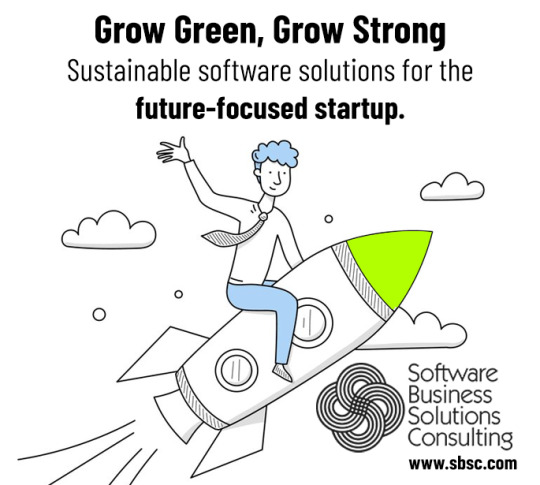
Are you a startup looking to make a positive impact alongside achieving your business goals? #SustainableSoftwareSolutions can help! These tools go beyond just functionality, offering features that can:
☁ Reduce your environmental footprint: Think #cloud-based solutions that minimize server energy consumption, or #SoftwareSolution that optimizes logistics and reduces waste.
♻ Boost resource efficiency: From managing remote teams to automating workflows, #SustainableSoftware can streamline operations and make the most of your resources.
📈 Enhance transparency and reporting: Track your sustainability efforts and measure your impact with data-driven tools. This builds trust with eco-conscious customers and investors.
Ready to explore how #SustainableSoftware can empower your startup? Share your goals with us, and let’s connect to discuss the best solutions for your business!
Read More: https://rb.gy/ldxftc Visit Website: https://shorturl.at/eAB78 Connect us: [email protected] | Call: +1 877 213 3835
#SustainableSoftwareDevelopment #GreenSoftwareDevelopment #sbsc
#Sustainable Software Development#green technology#sustainable software engineering practices#green software development#technology#cloud based software#enterprise software development#global software development#industry specific solutions#it consulting#it solutions for finance#it solutions for healthcare#enterprise social software
1 note
·
View note
Text
"Absolute Power would be good, actually," says usually patient and mild-mannered woman after trying to set up her mother's new computer.
#i would start with asking that someone bring me the heads of the people who designed Windows 11#just as an amuse-bouche#and then we'll go gather those responsible for green-lighting the use of subscriptions for softwares instead of one-time buy#next will be those who don't develop new drivers so you have to buy a new printer because yours is too old even if it works perfectly well#and then we'll be benevolent and ask that the Worshipers of the evil Investors gods renounce their evil ways#and if they don't#well#forests grow well on rotting flesh#blabla
4 notes
·
View notes
Text
#Green AI Revolution#Artificial Intelligence solutions#Software as a Service (saas)#Chatbot app development services
0 notes
Text
0 notes
Text
Grow green, grow strong: #SustainableSoftwareSolutions for the future-focused #startups.
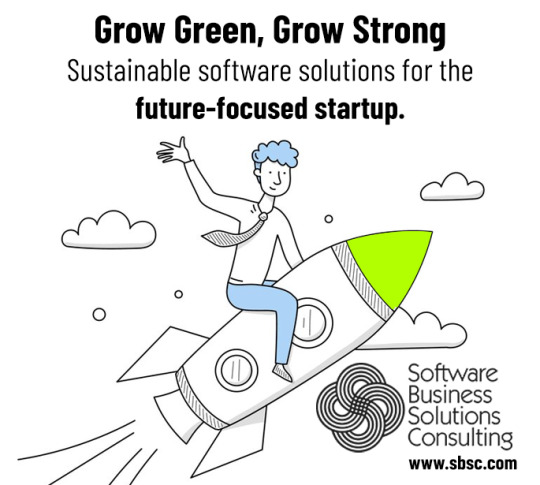
Are you a startup looking to make a positive impact alongside achieving your business goals? #SustainableSoftwareSolutions can help! These tools go beyond just functionality, offering features that can:
☁ Reduce your environmental footprint: Think #cloud-based solutions that minimize server energy consumption, or #SoftwareSolution that optimizes logistics and reduces waste.
♻ Boost resource efficiency: From managing remote teams to automating workflows, #SustainableSoftware can streamline operations and make the most of your resources.
📈 Enhance transparency and reporting: Track your sustainability efforts and measure your impact with data-driven tools. This builds trust with eco-conscious customers and investors.
Ready to explore how #SustainableSoftware can empower your startup? Share your goals with us, and let’s connect to discuss the best solutions for your business!
Read More: https://rb.gy/ldxftc Visit Website: https://shorturl.at/eAB78 Connect us: [email protected] | Call: +1 877 213 3835
#green technology#software development#sustainable software engineering practices#sustainable software#sbsc#Sustainable Software Development
1 note
·
View note
Text
How Software Development is Leading the Way to Sustainable AEC Industry
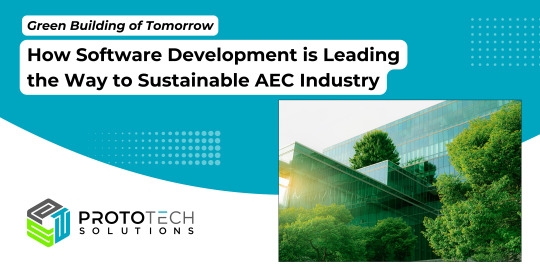
The world is working together to reduce the amount of carbon in the atmosphere, and all industries and sectors will have to contribute to this cause. The built environment is no exception. This term refers to the entire life cycle, including design, materials manufacturing, construction, usage, and demolition, of all residential and commercial buildings and infrastructure. The built environment is directly or indirectly responsible for about 40% of global CO₂ emissions from fuel combustion and 25% of overall greenhouse gas (GHG) emissions. As a result, it is one of the highest-emitting industries, emitting more than electricity production, shipping, and aviation.
According to McKinsey’s analysis, 76% of emissions in the life cycle of a typical building come from operations, while the remaining 24% is due to the processing of raw materials used for and construction of new builds. As 80% of the predicted building stock for 2050 already exists today, it is necessary to reduce not only embodied emissions but also operational emissions from the existing building stock to achieve decarbonization in the built environment.
Sustainable building practices aim to minimize the negative impact of construction on the environment by reducing energy consumption, waste generation, and harmful emissions. With advancements in technology and software development, the AEC industry is now able to design and construct buildings that are not only energy-efficient but also environmentally friendly.
In 2024, the integration of cutting-edge software solutions is at the forefront of this revolution, empowering stakeholders to create greener and more eco-friendly buildings. This blog explores the intersection of sustainability and software development in the AEC industry, highlighting the innovative technologies that are paving the way for green building practices. Here are the top 05 software development is paving the way for a green building future:
Read More: https://prototechsolutions.com/blog/how-software-development-is-leading-the-way-to-sustainable-aec-industry/
#carbon emissions#sustainable#sustainable architecture#green building#eco-friendly buildings#sustainable construction materials#sustainable building materials#software development#ProtoTech Solutions
0 notes
Text
🌿 Building a Sustainable Future: Green Practices in UK Software Development 🌍

The UK software development industry is going green! Embracing eco-friendly practices is key to a sustainable future. From energy-efficient coding to renewable-powered data centers, these companies are making a positive impact. 🌟
🖥️ Less energy, smarter coding, and remote work are reducing carbon footprints. 🌱
🌐 Join us in celebrating these green initiatives shaping a better, more eco-conscious tech industry! 🌿✨
This condensed post highlights the focus on sustainability in custom software development in UK while encouraging eco-consciousness and celebrating green initiatives.
#software development in UK#sustainability#green practices#eco-friendly#tech industry#UK software development
0 notes
Text
Software development is not an exception to how the tech sector is changing due to the demand for sustainability. The Top 10 Green Tech Software Development Companies of June 2025 that are setting the standard for environmentally responsible innovation are ranked in this post. These businesses create digital products with an emphasis on climate technology, carbon tracking, energy efficiency, and other topics. Through technology, they are assisting businesses in going green, from smart grid platforms to sustainable supply chain software. These companies are your go-to partners for creating software that has an impact on the environment, regardless of your size.
0 notes
Text
The conversation around AI is going to get away from us quickly because people lack the language to distinguish types of AI--and it's not their fault. Companies love to slap "AI" on anything they believe can pass for something "intelligent" a computer program is doing. And this muddies the waters when people want to talk about AI when the exact same word covers a wide umbrella and they themselves don't know how to qualify the distinctions within.
I'm a software engineer and not a data scientist, so I'm not exactly at the level of domain expert. But I work with data scientists, and I have at least rudimentary college-level knowledge of machine learning and linear algebra from my CS degree. So I want to give some quick guidance.
What is AI? And what is not AI?
So what's the difference between just a computer program, and an "AI" program? Computers can do a lot of smart things, and companies love the idea of calling anything that seems smart enough "AI", but industry-wise the question of "how smart" a program is has nothing to do with whether it is AI.
A regular, non-AI computer program is procedural, and rigidly defined. I could "program" traffic light behavior that essentially goes { if(light === green) { go(); } else { stop();} }. I've told it in simple and rigid terms what condition to check, and how to behave based on that check. (A better program would have a lot more to check for, like signs and road conditions and pedestrians in the street, and those things will still need to be spelled out.)
An AI traffic light behavior is generated by machine-learning, which simplistically is a huge cranking machine of linear algebra which you feed training data into and it "learns" from. By "learning" I mean it's developing a complex and opaque model of parameters to fit the training data (but not over-fit). In this case the training data probably includes thousands of videos of car behavior at traffic intersections. Through parameter tweaking and model adjustment, data scientists will turn this crank over and over adjusting it to create something which, in very opaque terms, has developed a model that will guess the right behavioral output for any future scenario.
A well-trained model would be fed a green light and know to go, and a red light and know to stop, and 'green but there's a kid in the road' and know to stop. A very very well-trained model can probably do this better than my program above, because it has the capacity to be more adaptive than my rigidly-defined thing if the rigidly-defined program is missing some considerations. But if the AI model makes a wrong choice, it is significantly harder to trace down why exactly it did that.
Because again, the reason it's making this decision may be very opaque. It's like engineering a very specific plinko machine which gets tweaked to be very good at taking a road input and giving the right output. But like if that plinko machine contained millions of pegs and none of them necessarily correlated to anything to do with the road. There's possibly no "if green, go, else stop" to look for. (Maybe there is, for traffic light specifically as that is intentionally very simplistic. But a model trained to recognize written numbers for example likely contains no parameters at all that you could map to ideas a human has like "look for a rigid line in the number". The parameters may be all, to humans, meaningless.)
So, that's basics. Here are some categories of things which get called AI:
"AI" which is just genuinely not AI
There's plenty of software that follows a normal, procedural program defined rigidly, with no linear algebra model training, that companies would love to brand as "AI" because it sounds cool.
Something like motion detection/tracking might be sold as artificially intelligent. But under the covers that can be done as simply as "if some range of pixels changes color by a certain amount, flag as motion"
2. AI which IS genuinely AI, but is not the kind of AI everyone is talking about right now
"AI", by which I mean machine learning using linear algebra, is very good at being fed a lot of training data, and then coming up with an ability to go and categorize real information.
The AI technology that looks at cells and determines whether they're cancer or not, that is using this technology. OCR (Optical Character Recognition) is the technology that can take an image of hand-written text and transcribe it. Again, it's using linear algebra, so yes it's AI.
Many other such examples exist, and have been around for quite a good number of years. They share the genre of technology, which is machine learning models, but these are not the Large Language Model Generative AI that is all over the media. Criticizing these would be like criticizing airplanes when you're actually mad at military drones. It's the same "makes fly in the air" technology but their impact is very different.
3. The AI we ARE talking about. "Chat-gpt" type of Generative AI which uses LLMs ("Large Language Models")
If there was one word I wish people would know in all this, it's LLM (Large Language Model). This describes the KIND of machine learning model that Chat-GPT/midjourney/stablediffusion are fueled by. They're so extremely powerfully trained on human language that they can take an input of conversational language and create a predictive output that is human coherent. (I am less certain what additional technology fuels art-creation, specifically, but considering the AI art generation has risen hand-in-hand with the advent of powerful LLM, I'm at least confident in saying it is still corely LLM).
This technology isn't exactly brand new (predictive text has been using it, but more like the mostly innocent and much less successful older sibling of some celebrity, who no one really thinks about.) But the scale and power of LLM-based AI technology is what is new with Chat-GPT.
This is the generative AI, and even better, the large language model generative AI.
(Data scientists, feel free to add on or correct anything.)
3K notes
·
View notes
Note
Has there been any instances where Mc and C did work together other than the fake baby thingy?
the science lab was filled with high schoolers scrambling to set up their projects, all of them either too caffeinated or not caffeinated enough for the stress of the prestigious state science fair in washington.
the tables were crammed with an impressive array of projects: models of volcanic eruptions, elaborate circuits blinking in synchronized colors, experiments with soil composition in tiny terrariums. but none of them held a candle to your table, and you knew it.
you worked quickly, your fingers deft as you adjusted the components of the intricate apparatus. the machine—an elegant contraption meant to demonstrate clean energy storage using solar capacitors—was you and C’s brainchild.
they had done the research, the design, the equations scribbled out with ruthless precision in their sharp handwriting. you’d handled the practical end of things: soldering wires, programming the software, ensuring that their theoretical masterpiece could actually, you know, work.
you didn’t notice the way C stood a few feet away, arms crossed tightly, their posture as stiff as a statue’s. their chalcedony green eyes followed your every move like a hawk watching its prey, catching each adjustment you made, each tool you reached for.
finally, they cleared their throat. “you’re doing it wrong.”
you sighed without turning around, tightening a bolt on the panel. “good morning to you, too, lacroix. nice to see you’re in a supportive mood today.”
“supportive?” their voice had that sharp, clipped quality it always took on when they thought you were being deliberately obtuse. “i’d be supportive if you weren’t—” they made an exasperated noise, gesturing vaguely at the machine. “look, the angles on the solar panels are all wrong. the light’s not going to hit them efficiently like that. it’s basic geometry. i explained this to you yesterday.”
“okay,” you said evenly, glancing at them over your shoulder. “anything else?”
C blinked, their expression flickering into something almost like confusion. “you’re just... accepting it? like that?”
“well, yeah,” you said, shrugging. “you’re the brains behind this, aren’t you? if you’ve got more suggestions, i’m open to them.”
C suddenly seemed at a loss for words. the tips of their ears turned a faint pink, and they glanced away.
“well, i, uh...” they began, before scowling at you like it was somehow your fault they’d stumbled. “fine! move the reflector two inches to the left.”
you did as they asked, your motions slow and deliberate. “happy?”
“stop talking to me,” C snapped.
you blinked at them, incredulous. “you’re the one bossing me around!”
C ignored you, their nose tilting upward in that infuriatingly haughty way they’d perfected.
***
when the judges arrived at your school’s section, the air grew thick with anticipation. there were four of them—an engineer from spacex, a college professor from MIT, a tech startup CEO, and some local entrepreneur who had been introduced as a ‘philanthropist.’
they moved from table to table with an efficiency that made your stomach churn. you’d been rehearsing your answers for days, but there was something about the way they scribbled on their clipboards that made even your confidence waver.
but the presentation began smoothly enough, much to your relief. C handled the technical explanations, their voice steady and precise as they guided the judges through the intricacies of your design. you handled the broader picture, spinning a compelling narrative about its real-world applications.
but when the judges started asking questions, something shifted.
“so, who came up with the original concept?” the engineer asked, pen poised over her notepad.
“well,” you started, “it was—”
“me,” C interrupted, their green eyes glinting. “i developed the initial framework.”
you gave them an irritated look. “what they actually meant to say was that it was a joint effort.”
“sure,” C drawled sarcastically. “you jointly borrowed my calculations and then messed up the assembly two separate times.”
you bristled. “maybe if your diagrams weren’t as convoluted as your personality, i wouldn’t have had to ‘mess up’ anything.”
“convoluted? that’s rich, coming from someone who thought capacitors and resistors were interchangeable—”
“that was one time, and it only happened because you mislabeled them!”
the judges exchanged glances, two of them clearly trying not to laugh, the other two looking mildly alarmed.
“would you say you two work well together?” another judge ventured cautiously.
“oh, absolutely,” you said, your tone dripping with sarcasm.
“can’t agree more,” C added, voice as flat as a table.
the judge raised an eyebrow, scribbling something down.
by the end of the presentation, both of you were red-faced and fuming, but the machine worked perfectly, and the judges seemed reluctantly impressed.
***
after the presentation, you and C sat side by side in the waiting area, the hum of chatter and distant applause filling the space. your hands rested in your lap, but when you shifted slightly, your fingers brushed against theirs. the accidental contact sent a jolt of heat up your arm, and you risked a glance at them.
C was staring angrily at the floor as if it had just demanded to drain their bank account, half of their face buried in the high collar of their dark green turtleneck. the tips of their ears had turned even more pink. their foot tapped against the floor in rapid, agitated beats.
when the winners were announced, your names rang out together, tethered like an inevitability.
you and C locked eyes, both startled, before standing up in unison. the applause was loud, but all you could focus on was the awkwardness of walking side by side to accept the award.
you still fell into step beside them, the trophy handed over in a flurry of handshakes and flashes from the crowd’s cameras.
the microphone passed between you two for the acceptance speech.
“we’d like to thank our school for supporting this project,” you began, glancing at C.
“and, of course, this wouldn’t have been possible without the cooperation of my... partner,” they added, their jaw tightening as if the words physically pained them to say.
you were tempted to laugh at how they looked like they were having a particularly bad case of indigestion, but managed to keep a straight face for the cameras.
***
after the ceremony, the two of you lingered near the refreshment table. C cleared their throat awkwardly, avoiding your gaze.
“you did... good,” they muttered.
you cocked your head, thinking you misheard them. “what?”
“i said you did good,” they repeated, louder this time. “you didn’t embarrass us. much.”
you snorted. “thanks, i guess. you weren’t too bad yourself.”
C hesitated, their eyes darting to the trophy in their right hand as their other hand fidgeted with the edge of their aldervale prep blazer.
“you’re smart though,” they said finally, their voice softer than usual. “you would’ve won without me.”
the admission startled you. “was that... a real compliment?”
this time, C’s cheeks turned pink as well, and they huffed loudly, turning on their heel. “i’m leaving. and i’m taking the trophy.”
“wait, what?” you snapped out of your stupor and hurried after them. “that’s not fair, lacroix! we both won!”
“too bad, starkid,” C called over their shoulder, their tone maddeningly smug. “you want it? come and get it.”
you groaned, chasing them through the crowd. “lacroix, get back here!”
and for the first time all day, C’s smile was genuine enough for their dimples to show.
#my god they’re stupid#fellas is it weirdly romantic to chase each other through crowds?#upcoming scenario is gonna be for M 😗#if: the ballad of the young gods#interactive fiction#interactive novel#interactive story#twine wip#ro: c lacroix#ro scenarios
230 notes
·
View notes
Text
Dandelion News - November 15-21
Like these weekly compilations? Tip me at $kaybarr1735 or check out my Dandelion Doodles! (sorry it's slightly late, the links didn't wanna work and I couldn't figure it out all day)
1. Wyoming's abortion ban has been overturned, including its ban on abortion medication

“Wyoming is the second state to have its near-total abortion ban overturned this month[…. Seven other states] also approved amendments protecting the right to an abortion. A lawsuit seeking to challenge the [FDA]’s approval of abortion medication recently failed when the Supreme Court refused to hear it[….]”
2. Patches of wildflowers in cities can be just as good for insects as natural meadows – study

“This study confirmed that small areas of urban wildflowers have a high concentration of pollinating insects, and are as valuable to many pollinators as larger areas of natural meadow that you would typically find rurally.”
3. Paris could offer new parents anti-pollution baby 'gift bags' to combat 'forever chemicals'

“The bag includes a stainless steel baby cup, a wooden toy, reusable cotton wipes, and non-toxic cleaning supplies as part of a "green prescription". […] The city will also have 44 centres for protecting mothers and infants that will be without any pollutants[….]”
4. Indigenous guardians embark on a sacred pact to protect the lowland tapir in Colombia

“The tapir is now the focus of an Indigenous-led conservation project[… A proposed “biocultural corridor”] will protect not only the populations and movements of wildlife such as tapirs, but also the cultural traditions and spirituality of the Inga and other neighboring Indigenous peoples[….]”
5. Denmark will plant 1 billion trees and convert 10% of farmland into forest

“[…] 43 billion kroner ($6.1 billion) have been earmarked to acquire land from farmers over the next two decades[.… In addition,] livestock farmers will be taxed for the greenhouse gases emitted by their cows, sheep and pigs from 2030, the first country to do so[….]”
6. The biggest grid storage project using old batteries is online in Texas

“[Element operates “used EV battery packs” with software that can] fine-tune commands at the cell level, instead of treating all the batteries as a monolithic whole. This enables the system to get more use out of each cell without stressing any so much that they break down[….]””
7. Durable supramolecular plastic is fully ocean-degradable and doesn't generate microplastics

“The new material is as strong as conventional plastics and biodegradable, [… and] is therefore expected to help reduce harmful microplastic pollution that accumulates in oceans and soil and eventually enters the food chain.”
8. Big Oil Tax Could Boost Global Loss and Damage Fund by 2000%

“[… A] tax on fossil fuel extraction, which would increase each year, combined with additional taxes on excess profits would […] generate hundreds of billions of dollars by the end of the decade to assist poor and vulnerable communities with the impact of the climate crisis[….]”
9. Rooftop solar meets 107.5 pct of South Australia’s demand, no emergency measures needed

“[T]he state was able to export around 658 MW of capacity to Victoria at the time[….] The export capacity is expected to increase significantly as the new transmission link to NSW[…] should be able to allow an extra 150 MW to be transferred in either direction by Christmas.”
10. Light-altering paint for greenhouses could help lengthen the fruit growing season in less sunny countries

“[Scientists] have developed a spray coating for greenhouses that could help UK farmers to produce more crops in the future using the same or less energy[… by optimising] the wavelength of light shining onto the plants, improving their growth and yield.”
November 8-14 news here | (all credit for images and written material can be found at the source linked; I don’t claim credit for anything but curating.)
#hopepunk#good news#abortion#abortion rights#reproductive rights#pollinators#guerrilla gardening#wildflowers#paris#babies#new parents#tapir#indigenous#denmark#reforestation#electric vehicles#energy storage#plastic#microplastics#biodegradable#fossil fuels#solar panels#gardening#solar energy#solar power#nature#us politics#technology#australia#uk
141 notes
·
View notes
Text

What is Sustainable Software? #Sustainablesoftware refers to the development and deployment of digital solutions that prioritize environmental, social, and economic sustainability throughout their lifecycle. This includes considerations such as energy efficiency, resource utilization, scalability, and the reduction of electronic waste. Sustainable software aims to mitigate negative environmental impacts while delivering value to your business.
Energy Efficiency: Energy consumption is a critical aspect of software sustainability. Developers strive to optimize code and utilize efficient algorithms to minimize the computational resources required for operation. This not only reduces carbon emissions but also lowers operational costs for businesses.
Minimal Resource Consumption: Sustainable software is designed to be lightweight and resource-efficient. By minimizing the use of memory, storage, and processing power, developers can reduce the environmental footprint of software applications, particularly in cloud computing environments where resource usage directly translates to energy consumption.
Longevity and Maintainability: Building software with longevity in mind is essential for sustainability. This involves writing clean, modular code that is easy to maintain and update over time. By prolonging the lifespan of software applications, developers can minimize the need for frequent replacements and reduce electronic waste.
Scalability and Flexibility: Sustainable software should be scalable to accommodate growth and changing requirements without significant environmental impact. Cloud-native architectures and containerization enable applications to scale dynamically based on demand, optimizing resource utilization and energy efficiency.
Open Source Collaboration: Embracing open source development practices fosters collaboration and knowledge sharing within the software community. Open source projects often prioritize sustainability by encouraging code reuse, peer review, and transparency in development processes.
Environmental Impact Reduction: By optimizing resource utilization and energy efficiency, sustainable software significantly reduces the carbon footprint associated with digital technologies. This is particularly important as the demand for computing power continues to rise.
Cost Savings: Energy-efficient software translates to lower operational costs for businesses, especially those operating large-scale data centers or cloud infrastructure. By optimizing resource usage, organizations can achieve significant savings on electricity bills and infrastructure expenses.
Improved Performance and User Experience: Sustainable software is often more reliable, responsive, and scalable than its resource-intensive counterparts. By prioritizing efficiency and optimization, developers can deliver better performance and user experience while minimizing downtime and latency.
Future-proofing Investments: Building software with sustainability in mind ensures its relevance and viability in the long term. As environmental regulations become more stringent and consumers demand eco-friendly products and services, businesses that invest in sustainable software will have a competitive advantage in the marketplace.
SBSC's venture into Eco-friendly solutions transcends mere software development; it ignites a green revolution across the tech landscape. This growing enthusiasm, alongside the escalating desire for sustainable software, foretells a future where it becomes the norm. With SBSC at the forefront, the technology sector holds the promise to emerge as a significant catalyst for positive change, fostering innovation while safeguarding our planet.
#sustainable software engineering practices#sustainable solutions#green technology#software development#cloud-based software#enterprise software development
1 note
·
View note
Text
"Nawy what do you MEAN quick-ish 3D render it's got scratches and everything and I thought this was real for a minute!!"
Well, first, thank you very much that was the intention ❤, and second, you see, all speed is relative, and between finding my references, modeling, texturing and lighting, on top of having to learn how to make convincing gems, it still took me quite a few hours. I, however, cut corners everywhere for speed, and I wouldn't put this piece in a portfolio in its current state.
But! for the curious, I thought I could do a simple breakdown of how the witchcraft happens, without using too much specialized language to make it more accessible. In short,

In this case, I’m talking about a 3D model that was textured (colours and stuff) and then lit (lights on!) to make a pretty final picture. The objective is not to make a tutorial, but to put in simple terms what a 3D artist does to make something go from this, to that:
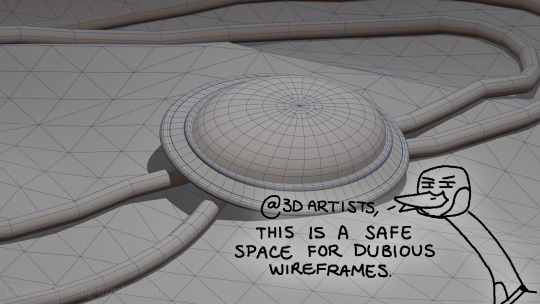

(people curious and/or trying to see if this interests them welcome)
I'm skipping the 3D modeling part altogether, since it isn't where most of the magic happens here. Just know that to be able to add colour and stuff on a 3D object, you have to go through the process or "unwrapping" it, which is like doing those foldable cubes in reverse
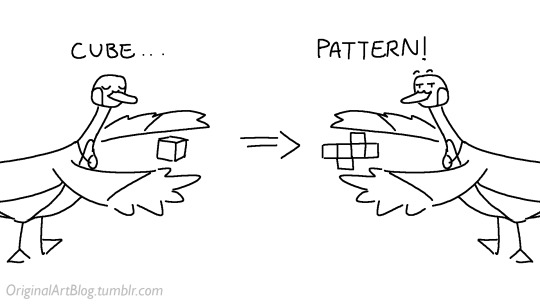
and then we can draw on it!!
Now, the good stuff:
Surfaces (metal, plastic, fabric, wood, skin, etc.) have different looks that make you able to differentiate them on sight. To make something look realistic, you have to try to replicate real life into the 3D world (duh.)
The software developers took care of the hard part (math and coding), so as artists we can play with the parameters available to make something pretty. What those parameters are depend on which "recipe" we're using. One of the most common "recipes" for realistic results is called PBR: Physically Based Rendering, named that way because it's trying to replicate real-life light physics. In this case, the 4 basic parameters are called albedo, roughness, metalness, and normal.
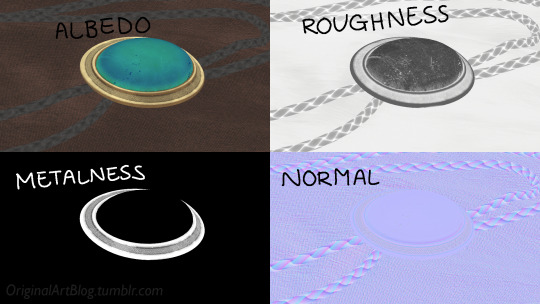
Albedo is the base colour of the surface (easy stuff). Roughness is to determine if a surface is rough or shiny. Metalness is to say if something is made out of metal or not. The normal is there to add all those tiny details you don't want to or can't sculpt on your 3D model (engravings, fabric bumps, etc.)
The roughness and metalness are black and white images because the information you're giving to the software is black = no and white = yes. It's easier to understand in the metalness image, where everything that is NOT a metal is black, and everything that IS a metal is white.
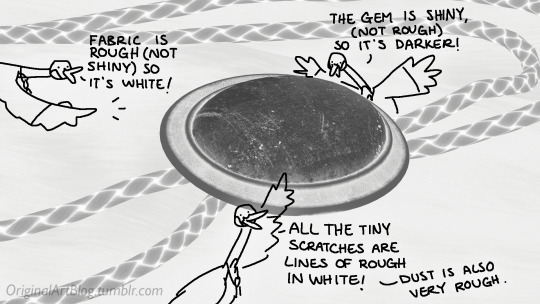
The normal is a bit more complex, but in short, it uses the colours green and red to know what is up/down or left/right, and will help the software fake relief on top of the model. You don't make it by hand; it's computer-generated from other stuff I'm not getting into.

With the technical stuff out of the way, we can actually use these. There are specialized softwares that will let you preview the results of each parameter in real time, so you can see what you're doing easily. This is what I have.
That software comes with some types of surfaces that are already set up, like the fabric in my piece, which was already 85% good for me straight out of the box. Then, it's up to me to use the tools available to decide how shiny a surface is, if there's dust or scratches and where, what colours things are, if there's metal parts, etc. That's where you can see a 3D artist's skills.
And finally, you bring it all together into a specialized software that can render 3D stuff and use those images on the corresponsing parameters, and then light the scene.
Because it all comes down to this: the light! For something realistic, light is vital to get right. You can pour your heart and soul into those tiny scratches, but if you don't light the scene correctly, well...
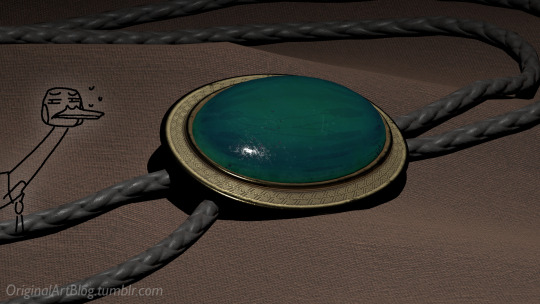
So we carefully light the scene to get some nice highlights to make the textures look good and highlight our subject (it's basically a photography studio inside a computer)

And then we add some camera effects...

and voilà! pretty picture!!
... and if you somehow did notice something different with the bolo tie from my last post, I did find out while taking all these screenshots that I messed up my initial renders in a way that made everything darker than it was supposed to be and that's why my gold looked so muddy...


I hope this was interesting and that you learned a thing or two!
#welcome to nawy's 3d school for complete beginners#nawy's 3d#technically not art but... you know...
377 notes
·
View notes